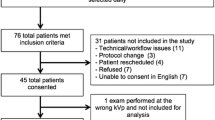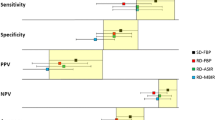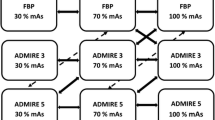Abstract
Purpose
To prospectively study CT dose reduction using the “prior image constrained compressed sensing” (PICCS) reconstruction technique.
Methods
Immediately following routine standard dose (SD) abdominal MDCT, 50 patients (mean age, 57.7 years; mean BMI, 28.8) underwent a second reduced dose (RD) scan (targeted dose reduction, 70%–90%). DLP, CTDIvol, and SSDE were compared. Several reconstruction algorithms (FBP, ASIR, and PICCS) were applied to the RD series. SD images with FBP served as reference standard. Two blinded readers evaluated each series for subjective image quality and focal lesion detection.
Results
Mean DLP, CTDIvol, and SSDE for RD series were 140.3 mGy cm (median 79.4), 3.7 mGy (median 1.8), and 4.2 mGy (median 2.3) compared with 493.7 mGy cm (median 345.8), 12.9 mGy (median 7.9 mGy), and 14.6 mGy (median 10.1) for SD series, respectively. Mean effective patient diameter was 30.1 cm (median 30), which translates to a mean SSDE reduction of 72% (P < 0.001). RD-PICCS image quality score was 2.8 ± 0.5, improved over the RD-FBP (1.7 ± 0.7) and RD-ASIR (1.9 ± 0.8) (P < 0.001), but lower than SD (3.5 ± 0.5) (P < 0.001). Readers detected 81% (184/228) of focal lesions on RD-PICCS series, vs. 67% (153/228) and 65% (149/228) for RD-FBP and RD-ASIR, respectively. Mean image noise was significantly reduced on RD-PICCS series (13.9 HU) compared with RD-FBP (57.2) and RD-ASIR (44.1) (P < 0.001).
Conclusion
PICCS allows for marked dose reduction at abdominal CT with improved image quality and diagnostic performance over reduced dose FBP and ASIR. Further study is needed to determine indication-specific dose reduction levels that preserve acceptable diagnostic accuracy relative to higher dose protocols.








Similar content being viewed by others
References
Brenner DJ, Hall EJ (2007) Computed tomography—an increasing source of radiation exposure. N Engl J Med 357(22):2277–2284
Mahesh M (2009) NCRP report number 160: its significance to medical imaging. J Am Coll Radiol 6(12):890–892
Measurements NCoRPa (1987) Ionizing radiation exposure of the population of the United States. Bethesda: NCoRPa
Pearce MS, Salotti JA, Little MP, et al. (2012) Radiation exposure from CT scans in childhood and subsequent risk of leukaemia and brain tumours: a retrospective cohort study. Lancet 380(9840):499–505
McCollough CH, Primak AN, Braun N, et al. (2009) Strategies for reducing radiation dose in CT. Radiol Clin N Am 47(1):27–40
Mulkens TH, Bellinck P, Baeyaert M, et al. (2005) Use of an automatic exposure control mechanism for dose optimization in multi-detector row CT examinations: clinical evaluation. Radiology 237(1):213–223
McCollough CH, Bruesewitz MR, Kofler JM Jr (2006) CT dose reduction and dose management tools: overview of available options. Radiographics 26(2):503–512
Graser A, Wintersperger BJ, Suess C, Reiser MF, Becker CR (2006) Dose reduction and image quality in MDCT colonography using tube current modulation. AJR Am J Roentgenol 187(3):695–701
Greess H, Wolf H, Baum U, et al. (2000) Dose reduction in computed tomography by attenuation-based on-line modulation of tube current: evaluation of six anatomical regions. Eur Radiol 10(2):391–394
McCollough CH (2005) Automatic exposure control in CT: are we done yet? Radiology 237(3):755–756
Gies M, Kalender WA, Wolf H, Suess C (1999) Dose reduction in CT by anatomically adapted tube current modulation. I. Simulation studies. Med Phys 26(11):2235–2247
Kalender WA, Wolf H, Suess C (1999) Dose reduction in CT by anatomically adapted tube current modulation. II. Phantom measurements. Med Phys 26(11):2248–2253
Haaga JR, Miraldi F, MacIntyre W, et al. (1981) The effect of mAs variation upon computed tomography image quality as evaluated by in vivo and in vitro studies. Radiology 138(2):449–454
Goetti R, Winklehner A, Gordic S, et al. (2012) Automated attenuation-based kilovoltage selection: preliminary observations in patients after endovascular aneurysm repair of the abdominal aorta. AJR Am J Roentgenol 199(3):W380–W385
Supanich M, Tao Y, Nett B, et al. (2009) Radiation dose reduction in time-resolved CT angiography using highly constrained back projection reconstruction. Phys Med Biol 54(14):4575–4593
Marin D, Nelson RC, Schindera ST, et al. (2010) Low-tube-voltage, high-tube-current multidetector abdominal CT: improved image quality and decreased radiation dose with adaptive statistical iterative reconstruction algorithm—initial clinical experience. Radiology 254(1):145–153
Prakash P, Kalra MK, Kambadakone AK, et al. (2010) Reducing abdominal CT radiation dose with adaptive statistical iterative reconstruction technique. Invest Radiol 45(4):202–210
Silva AC, Lawder HJ, Hara A, Kujak J, Pavlicek W (2010) Innovations in CT dose reduction strategy: application of the adaptive statistical iterative reconstruction algorithm. AJR Am J Roentgenol 194(1):191–199
Thibault JB, Sauer KD, Bouman CA, Hsieh J (2007) A three-dimensional statistical approach to improved image quality for multislice helical CT. Med Phys 34(11):4526–4544
Chen GH, Tang J, Leng S (2008) Prior image constrained compressed sensing (PICCS): a method to accurately reconstruct dynamic CT images from highly undersampled projection data sets. Med Phys 35(2):660–663
Pickhardt PJ, Lubner MG, Kim DH, et al. (2012) Abdominal CT with model-based iterative reconstruction (MBIR): initial results of a prospective trial comparing ultralow-dose with standard-dose imaging. AJR Am J Roentgenol 199(6):1266–1274
Chang W, Lee JM, Lee K, et al. (2013) Assessment of a model-based, iterative reconstruction algorithm (MBIR) regarding image quality and dose reduction in liver computed tomography. Invest Radiol 48:598–606
Hara AK, Paden RG, Silva AC, et al. (2009) Iterative reconstruction technique for reducing body radiation dose at CT: feasibility study. AJR Am J Roentgenol 193(3):764–771
Sagara Y, Hara AK, Pavlicek W, et al. (2010) Abdominal CT: comparison of low-dose CT with adaptive statistical iterative reconstruction and routine-dose CT with filtered back projection in 53 patients. AJR Am J Roentgenol 195(3):713–719
Kambadakone AR, Chaudhary NA, Desai GS, et al. (2011) Low-dose MDCT and CT enterography of patients with Crohn disease: feasibility of adaptive statistical iterative reconstruction. AJR Am J Roentgenol 196(6):W743–W752
Mitsumori LM, Shuman WP, Busey JM, Kolokythas O, Koprowicz KM (2012) Adaptive statistical iterative reconstruction versus filtered back projection in the same patient: 64 channel liver CT image quality and patient radiation dose. Eur Radiol 22(1):138–143
McCollough CH, Chen GH, Kalender W, et al. (2012) Achieving routine submillisievert CT scanning: report from the summit on management of radiation dose in CT. Radiology 264(2):567–580
Lubner MG, Pickhardt PJ, Tang J, Chen GH (2011) Reduced image noise at low-dose multidetector CT of the abdomen with prior image constrained compressed sensing algorithm. Radiology 260(1):248–256
McCollough C, Cody D, Edyvean S, et al. (2008) The measurement, reporting and management of radiation dose in CT. College Park: American Association of Physicists in Medicine
Deak PD, Smal Y, Kalender WA (2010) Multisection CT protocols: sex- and age-specific conversion factors used to determine effective dose from dose-length product. Radiology 257(1):158–166
Boone JM, Strauss KJ, Cody DD, et al. (2011) Size-specific dose estimates (SSDE) in pediatric and adult body CT examinations. College Park: American Association of Physicists in Medicine
Bankier AA, Kressel HY (2012) Through the looking glass revisited: the need for more meaning and less drama in the reporting of dose and dose reduction in CT. Radiology 265(1):4–8
Flicek KT, Hara AK, Silva AC, et al. (2010) Reducing the radiation dose for CT colonography using adaptive statistical iterative reconstruction: a pilot study. AJR Am J Roentgenol 195(1):126–131
Tang JT-LP, Chen G-H (2011) In: Proceedings of SPIE, Medical Imaging. Physics of Medical Imaging, vol 7961
Agresti ACB (1998) Approximate is better than “Exact” for interval estimation of binomial proportions. Am Stat 52(2):119–126
Pinheiro JCBD (2000) Mixed-effects models in S and S-PLUS. New York: Springer
R Development Core Team (2009) R: a language and environment for statistical computing. Vienna: R Foundation for Statistical Computing
Singh S, Kalra MK, Hsieh J, et al. (2010) Abdominal CT: comparison of adaptive statistical iterative and filtered back projection reconstruction techniques. Radiology 257(2):373–383
Noel PB, Fingerle AA, Renger B, et al. (2011) Initial performance characterization of a clinical noise-suppressing reconstruction algorithm for MDCT. AJR Am J Roentgenol 197(6):1404–1409
Lee SJ, Park SH, Kim AY, et al. (2011) A prospective comparison of standard-dose CT enterography and 50% reduced-dose CT enterography with and without noise reduction for evaluating Crohn disease. AJR Am J Roentgenol 197(1):50–57
Gervaise A, Osemont B, Lecocq S, et al. (2012) CT image quality improvement using Adaptive iterative dose reduction with wide-volume acquisition on 320-detector CT. Eur Radiol 22(2):295–301
Baker ME, Dong F, Primak A, et al. (2012) Contrast-to-noise ratio and low-contrast object resolution on full- and low-dose MDCT: SAFIRE versus filtered back projection in a low-contrast object phantom and in the liver. AJR Am J Roentgenol 199(1):8–18
Acknowledgments
This work was partially supported by NIH Grant funding R01CA169331.
Author information
Authors and Affiliations
Corresponding author
Appendix
Appendix
See Table 9.
Rights and permissions
About this article
Cite this article
Lubner, M.G., Pickhardt, P.J., Kim, D.H. et al. Prospective evaluation of prior image constrained compressed sensing (PICCS) algorithm in abdominal CT: a comparison of reduced dose with standard dose imaging. Abdom Imaging 40, 207–221 (2015). https://doi.org/10.1007/s00261-014-0178-x
Published:
Issue Date:
DOI: https://doi.org/10.1007/s00261-014-0178-x




